
Medical technology company Integer Holdings (NYSE: ITGR) beat Wall Street’s revenue expectations in Q4 CY2024, with sales up 11.1% year on year to $449.5 million. The company’s full-year revenue guidance of $1.86 billion at the midpoint came in 1.1% above analysts’ estimates. Its non-GAAP profit of $1.43 per share was 2% below analysts’ consensus estimates.
Is now the time to buy Integer Holdings? Find out by accessing our full research report, it’s free.
Integer Holdings (ITGR) Q4 CY2024 Highlights:
- Revenue: $449.5 million vs analyst estimates of $446.8 million (11.1% year-on-year growth, 0.6% beat)
- Adjusted EPS: $1.43 vs analyst expectations of $1.46 (2% miss)
- Adjusted EBITDA: $95.07 million vs analyst estimates of $98.03 million (21.1% margin, 3% miss)
- Management’s revenue guidance for the upcoming financial year 2025 is $1.86 billion at the midpoint, beating analyst estimates by 1.1% and implying 8.5% growth (vs 10.4% in FY2024)
- Adjusted EPS guidance for the upcoming financial year 2025 is $6.02 at the midpoint, missing analyst estimates by 0.7%
- EBITDA guidance for the upcoming financial year 2025 is $411.5 million at the midpoint, above analyst estimates of $403.9 million
- Operating Margin: 12.7%, up from 10.8% in the same quarter last year
- Free Cash Flow Margin: 9.8%, up from 4.6% in the same quarter last year
- Organic Revenue rose 10.6% year on year (9.5% in the same quarter last year)
- Market Capitalization: $4.80 billion
“Integer delivered strong fourth quarter and full year 2024 sales and income with full year sales up 10% and adjusted operating income up 20%,” said Joseph Dziedzic, Integer’s president and CEO.
Company Overview
Founded in 1940, Integer Holdings (NYSE: ITGR) designs and manufactures critical components and systems for medical device original equipment manufacturers (OEMs), with a focus on cardiovascular, neurostimulation, and portable medical device markets.
Medical Devices & Supplies - Specialty
The medical devices industry operates a business model that balances steady demand with significant investments in innovation and regulatory compliance. The industry benefits from recurring revenue streams tied to consumables, maintenance services, and incremental upgrades to the latest technologies, although specialty devices are more niche. The capital-intensive nature of product development, coupled with lengthy regulatory pathways and the need for clinical validation, can weigh on profitability and timelines. In addition, there are constant pricing pressures from healthcare systems and insurers maximizing cost efficiency. Over the next several years, one tailwind is demographic–aging populations means rising chronic disease rates that drive greater demand for medical interventions and monitoring solutions. Advances in digital health, such as remote patient monitoring and smart devices, are also expected to unlock new demand by shortening upgrade cycles. On the other hand, the industry faces headwinds from pricing and reimbursement pressures as healthcare providers increasingly adopt value-based care models. Additionally, the integration of cybersecurity for connected devices adds further risk and complexity for device manufacturers.
Sales Growth
A company’s long-term sales performance signals its overall quality. Even a bad business can shine for one or two quarters, but a top-tier one grows for years. Unfortunately, Integer Holdings’s 6.4% annualized revenue growth over the last five years was mediocre. This fell short of our benchmark for the healthcare sector and is a tough starting point for our analysis.
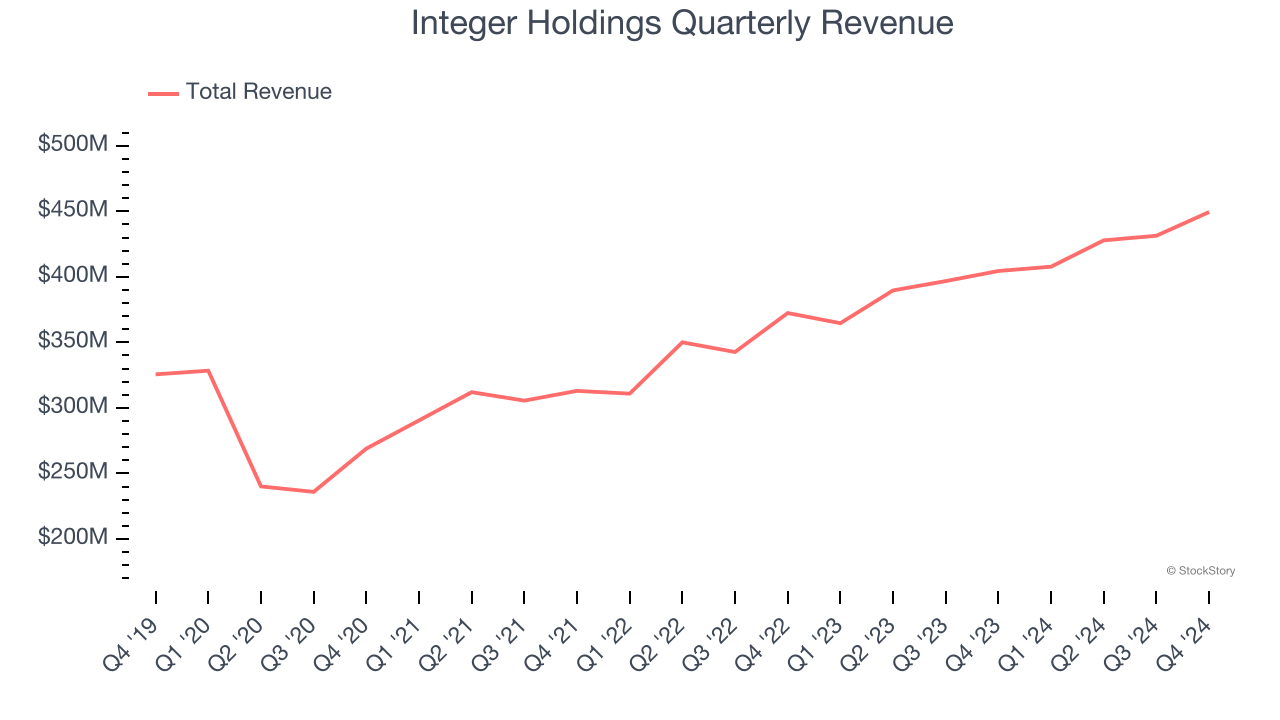
We at StockStory place the most emphasis on long-term growth, but within healthcare, a half-decade historical view may miss recent innovations or disruptive industry trends. Integer Holdings’s annualized revenue growth of 11.7% over the last two years is above its five-year trend, suggesting some bright spots. 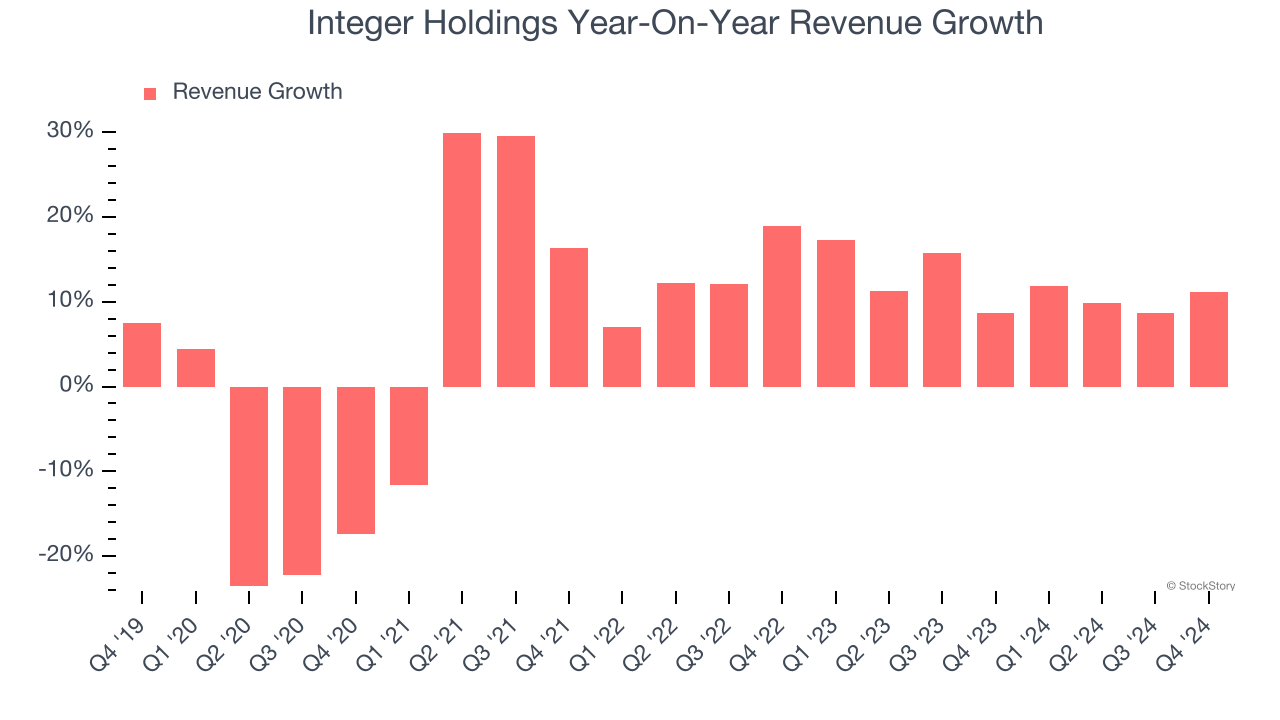
We can dig further into the company’s sales dynamics by analyzing its organic revenue, which strips out one-time events like acquisitions and currency fluctuations that don’t accurately reflect its fundamentals. Over the last two years, Integer Holdings’s organic revenue averaged 11.1% year-on-year growth. Because this number aligns with its normal revenue growth, we can see the company’s core operations (not acquisitions and divestitures) drove most of its results. 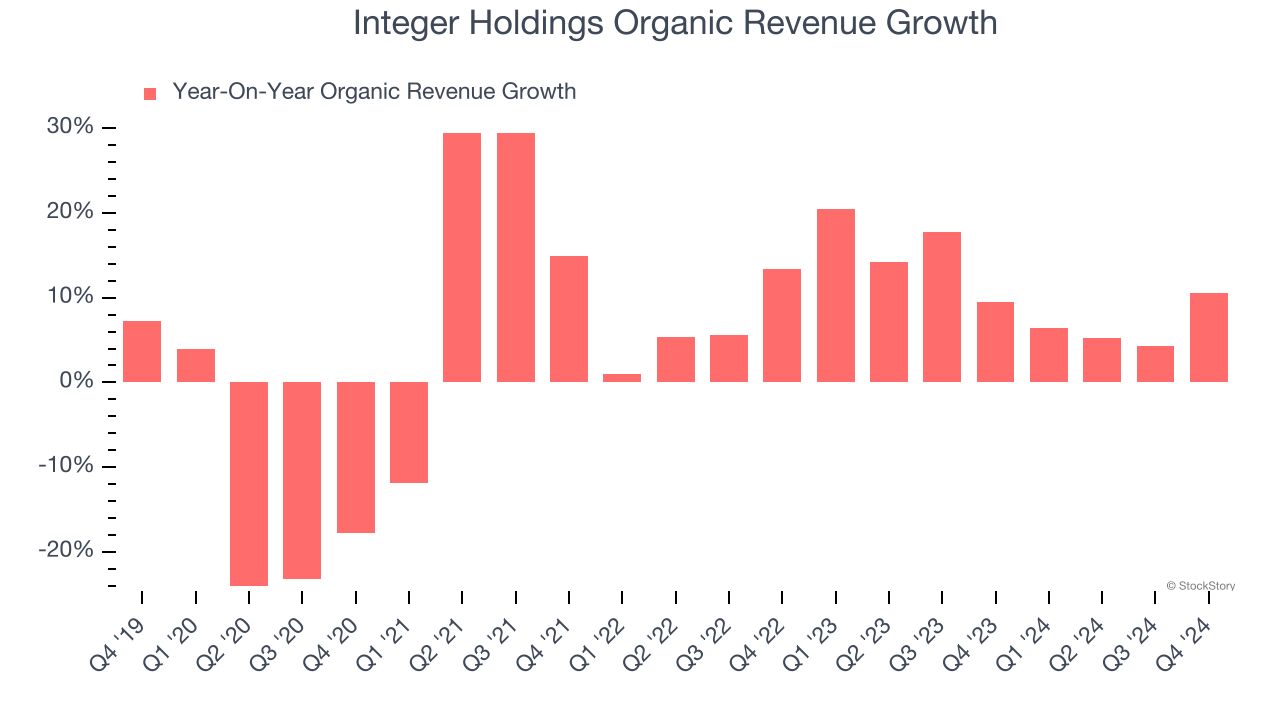
This quarter, Integer Holdings reported year-on-year revenue growth of 11.1%, and its $449.5 million of revenue exceeded Wall Street’s estimates by 0.6%.
Looking ahead, sell-side analysts expect revenue to grow 7.5% over the next 12 months, a deceleration versus the last two years. Still, this projection is above the sector average and suggests the market is factoring in some success for its newer products and services.
Software is eating the world and there is virtually no industry left that has been untouched by it. That drives increasing demand for tools helping software developers do their jobs, whether it be monitoring critical cloud infrastructure, integrating audio and video functionality, or ensuring smooth content streaming. Click here to access a free report on our 3 favorite stocks to play this generational megatrend.
Operating Margin
Operating margin is an important measure of profitability as it shows the portion of revenue left after accounting for all core expenses – everything from the cost of goods sold to advertising and wages. It’s also useful for comparing profitability across companies with different levels of debt and tax rates because it excludes interest and taxes.
Integer Holdings has done a decent job managing its cost base over the last five years. The company has produced an average operating margin of 10.9%, higher than the broader healthcare sector.
Analyzing the trend in its profitability, Integer Holdings’s operating margin of 12.1% for the trailing 12 months may be around the same as five years ago, but it has increased by 3.3 percentage points over the last two years.
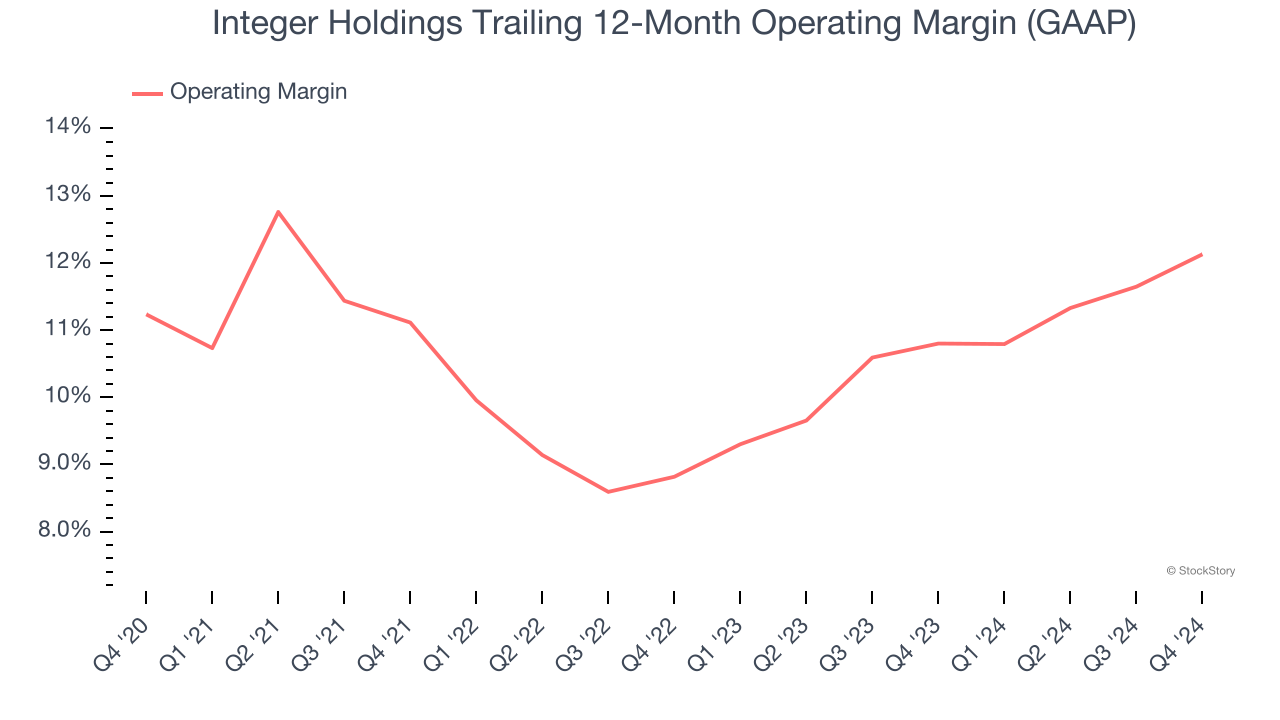
In Q4, Integer Holdings generated an operating profit margin of 12.7%, up 1.9 percentage points year on year. This increase was a welcome development and shows it was recently more efficient because its expenses grew slower than its revenue.
Earnings Per Share
Revenue trends explain a company’s historical growth, but the long-term change in earnings per share (EPS) points to the profitability of that growth – for example, a company could inflate its sales through excessive spending on advertising and promotions.
Integer Holdings’s EPS grew at an unimpressive 2.5% compounded annual growth rate over the last five years, lower than its 6.4% annualized revenue growth. However, its operating margin didn’t change during this time, telling us that non-fundamental factors such as interest and taxes affected its ultimate earnings.
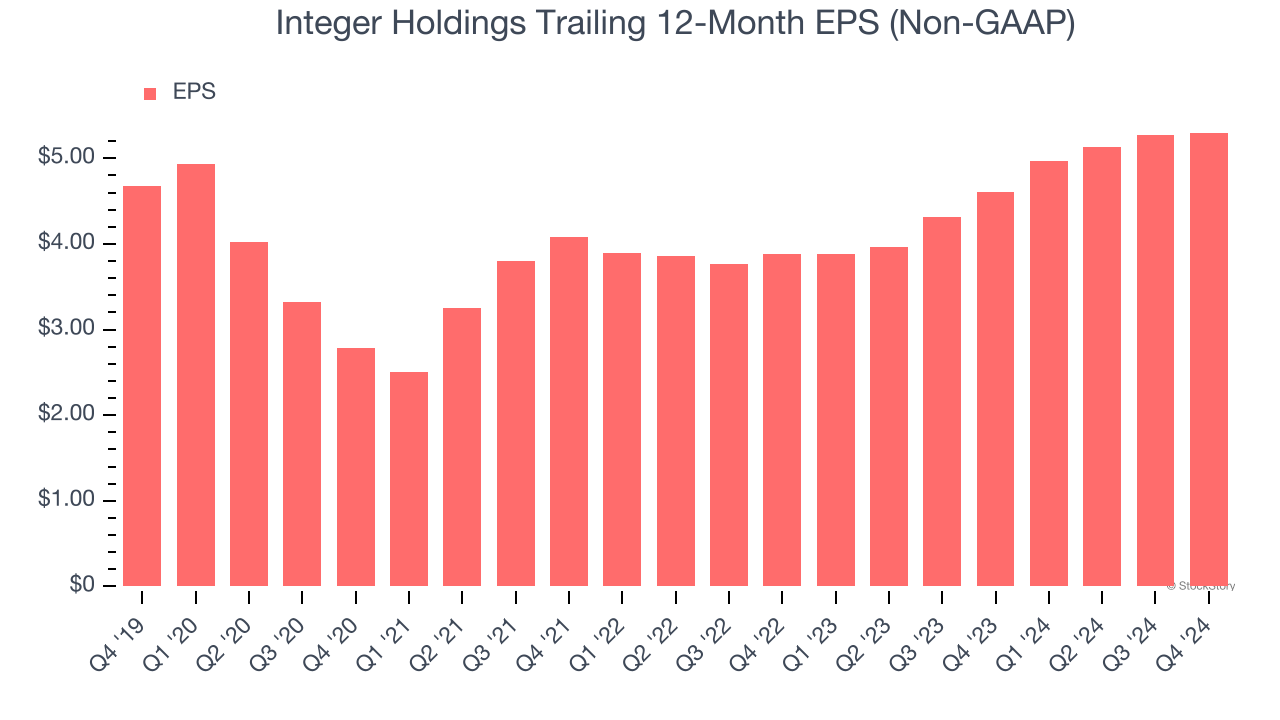
Diving into the nuances of Integer Holdings’s earnings can give us a better understanding of its performance. A five-year view shows Integer Holdings has diluted its shareholders, growing its share count by 9.5%. This has led to lower per share earnings. Taxes and interest expenses can also affect EPS but don’t tell us as much about a company’s fundamentals. 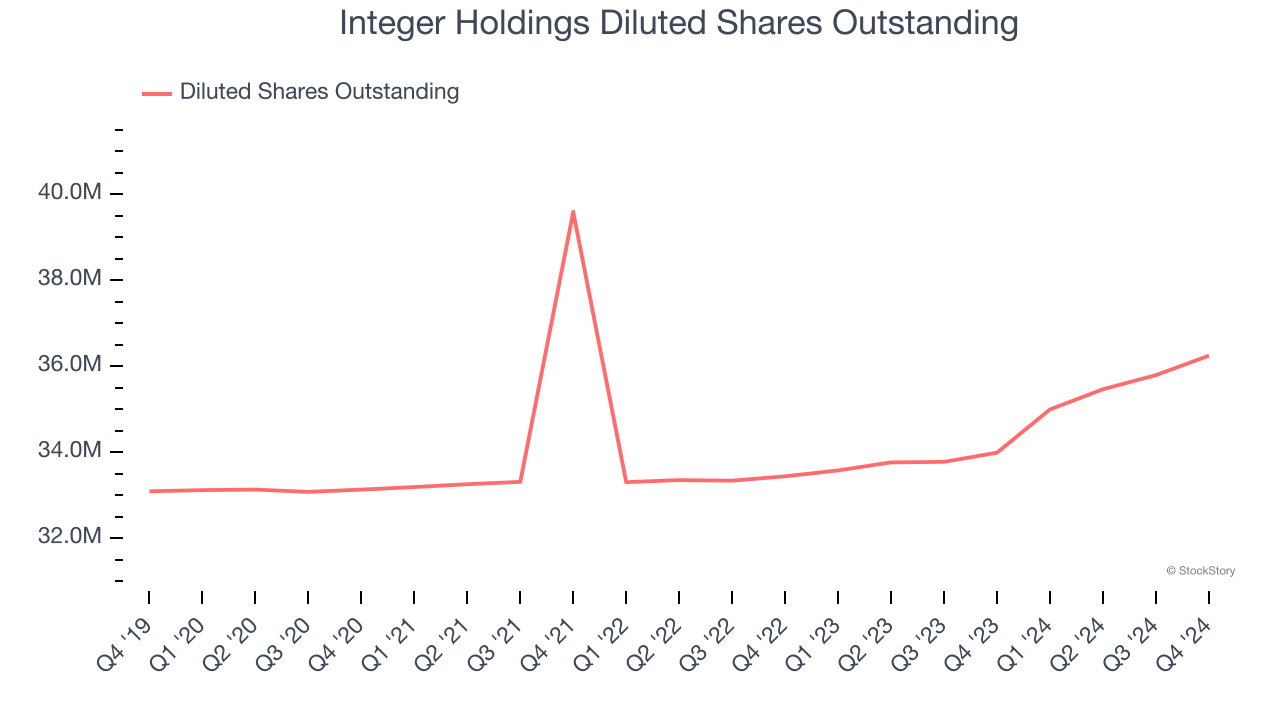
In Q4, Integer Holdings reported EPS at $1.43, up from $1.41 in the same quarter last year. Despite growing year on year, this print slightly missed analysts’ estimates. Over the next 12 months, Wall Street expects Integer Holdings’s full-year EPS of $5.30 to grow 13.8%.
Key Takeaways from Integer Holdings’s Q4 Results
It was good to see Integer Holdings provide full-year revenue and EBITDA guidance that topped analysts’ expectations. We were also glad this quarter's revenue beat. On the other hand, its EPS and EBITDA missed, and its full-year EPS guidance fell slightly short of Wall Street’s estimates. Zooming out, we think this was a mixed quarter featuring some areas of strength but also some blemishes. The market seemed to focus on the negatives, and the stock traded down 1.4% to $141.50 immediately after reporting.
Should you buy the stock or not? When making that decision, it’s important to consider its valuation, business qualities, as well as what has happened in the latest quarter. We cover that in our actionable full research report which you can read here, it’s free.





